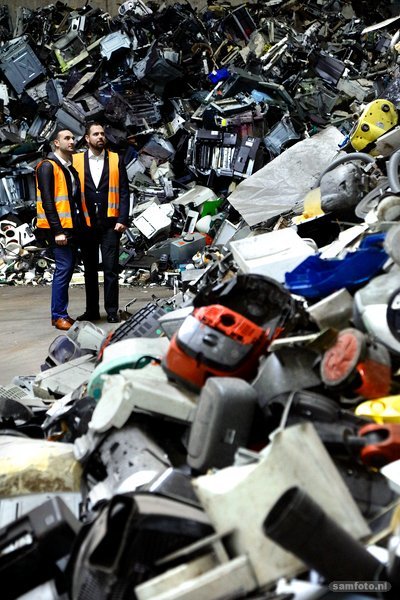Circularise uses blockchain technology to trace raw materials
The amount of electrical and electronic waste in Europe is growing rapidly. Every year, around 10 million tonnes of old computers, televisions, refrigerators, tablets and mobile phones end up on the scrap heap. But what happens then?
Exporting it all to Africa, India and China is a no-go. But as long as recycling in Europe is difficult and expensive, illegal dumping will continue to be popular. The WEEE (waste electric and electronic equipment) export ban was introduced due to the poor working conditions that prevail in the receiving countries, as well as the fact that this waste would poison the local populations and the realisation that electrical devices contain raw materials that will soon become scarce.
To demonstrate the arduous recycling process in Europe, Mesbah Sabur, one of the founders of Circularise, plays a video of how monitors are recycled in Italy. Some monitors have a tubular mercury lamp that needs to be removed. But because no one knows which monitors are fitted with one of these lamps, they all have to be opened by hand for inspection. Wouldn’t it be great if you could just scan a QR code and find out straight away whether there is any mercury in it or not? Well, Delft-based start-up Circularise has developed such a solution,
which involves a huge number of parties: mining companies, blast furnaces, component manufacturers, electronics manufacturers, consumers, collection services and recycling companies. And all these parties want to ensure their privacy; manufacturers do not want to publish their trade secrets and consumers want to protect their possessions. And nobody would ever agree to a global central database that traces the use of raw materials.
Most people would just give up at that point, but not Jordi de Vos. He is co-founder of Circularise and describes himself as a blockchain aficionado.
For those who are not experts like De Vos, a blockchain is a network in which all transactions between parties are secured (a block) and linked (the chain) to previous and subsequent transactions made by those parties. There is no central database. The register is divided among all participants, so it is not possible to commit fraud. Encryption ensures that each participant sees only their own transactions, and those transactions cannot be changed.
And what about trade secrets? To get around this, De Vos uses a mind-boggling logic known as zero-knowledge proof. This is a method by which questions are repeated to ensure certainty without revealing the secret itself. To determine whether a certain monitor contains mercury, for example, the network can retrieve data from parts manufacturers and producers by using smart questioning. The longer it takes to search in the network, the more certain the answer.
The register is divided among all participants, so it's not possible to commit fraud
In practice, Circularise’s raw materials inventory works using a small QR code on the product. The start-up charges 1 cent for that. But for 15 cents, Circularise offers companies a ‘plus’ label that allows them to keep in touch with their customers. This is perhaps the kind of added value that appeals more to companies than EU regulations.
